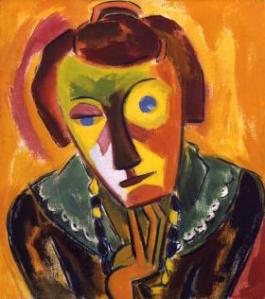Bloom’s Taxonomy and Art (Story)
By Ashley Weinard, NCMA Educator and Project Director, The Big Picture
How do you apply Bloom’s Taxonomy to a work of art? The outline below shows how you can hit a full range of skills in just one discussion. Try out these prompts with the NCMA’s Portrait of Emy by Karl Schmidt-Rottluff.
Knowledge (remember)
1. How would you describe the expression on Emy’s face?
2. List at least three colors on Emy’s face.
Comprehension (understand)
1. What differences do you see between Emy’s face and the face of your partner?
2. What patterns do you see in Emy’s face?
Application (apply)
1. How would this work of art be different if the artist had used cool colors instead of warm ones?
2. Describe the colors you would use to depict a specific feeling or mood.
3. Knowing what you know about the properties of light, do you think the artist was “playing with light?” Explain your answer.
Analysis (analyze)
1. What relationship exists between the orange background and the rest of the portrait?
2. Discuss the pros and cons of using color to portray feelings.
3. Knowing that Emy is the artist’s wife, do you think he painted her portrait as he saw her, or do you think he painted what he wanted the audience to see?
Synthesis (create)
1. Keeping her expression exactly the same, create an alternative portrait of Emy using different colors.
2. Create a written portrait of Emy. Base your text on the artist’s selection of color, details, and mood.
3. Predict how the portrait would look if the coloring of Emy’s face was symmetrical.
Evaluation (evaluate)
1. Based on the discussion so far, what do you think is the most important aspect of the Portrait of Emy?
2. How would you prove or disprove that colors can affect our feelings?
3. How does knowing that Emy is the artist’s wife change your view of the painting?
Adapted from a lesson developed by Joan Certa-Moore.


